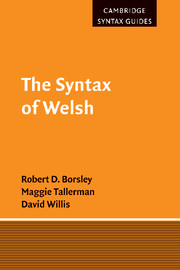2 - Simple finite clauses
Published online by Cambridge University Press: 01 October 2009
Summary
In this chapter, we look at simple finite clauses, largely ignoring wh interrogatives, relative clauses and focus sentences, which we consider in chapter 4. As noted in chapter 1, Welsh, like the other Celtic languages, is a VSO language with a verb or an auxiliary in pre-subject position in all finite clauses. In the latter case, a non-finite form of the lexical verb follows the subject. We outline the main features of verb-initial and auxiliary-initial clauses and discuss how they should be analysed. In transformational work it has generally been assumed that verb-initial clauses are the result of movement, and this has often been assumed for some auxiliary-initial clauses as well. There has been considerable debate about the precise location of both the verb/auxiliary and the following subject. It is possible to have an analogue of verb/auxiliary-movement in a non-transformational framework. However, the main non-transformational analysis has assumed a flat structure, in which subject and object are both sisters of the verb. There is a major unresolved issue here. Do Welsh finite clauses contain a VP like finite clauses in many other languages? Or not?
We begin in section 2.1 by looking at some basic properties of simple finite clauses. Then, in section 2.2, a number of types of auxiliary-initial clauses are discussed. In sections 2.3 and 2.4 we consider first transformational and then non-transformational analyses of finite clauses. Then, in section 2.5, we discuss analyses of auxiliary-initial clauses. Finally, in section 2.6, we consider a number of additional issues that arise here.
Information
- Type
- Chapter
- Information
- The Syntax of Welsh , pp. 32 - 67Publisher: Cambridge University PressPrint publication year: 2007
